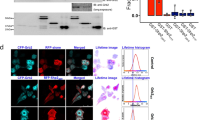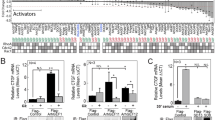Abstract
Previously we cloned a novel adaptor protein, APS (adaptor molecules containing PH and SH2 domains) which was tyrosine phosphorylated in response to c-kit or B cell receptor stimulation. Here we report that APS was expressed in some human osteosarcoma cell lines, markedly so in SaOS-2 cells, and was tyrosine-phosphorylated in response to several growth factors, including platelet derived growth factor (PDGF), insulin-like growth factor (IGF), and granulocyte-macrophage colony stimulating factor (GM-CSF). Ectopic expression of the wild type APS, but not C-terminal truncated APS, in NIH3T3 fibroblasts suppressed PDGF-induced MAP kinase (Erk2) activation, c-fos and c-myc induction as well as cell proliferation. In vitro binding experiments suggest that APS bound to the β type PDGF receptor, mainly via phosphotyrosine 1021 (pY1021). Indeed, tyrosine phosphorylation of PLC-γ, which has been demonstrated to bind to pY1021, but not that of PI3 kinase and associated proteins, was reduced in APS transformants. PDGF induced phosphorylation of the tyrosine residue of APS close to the C-terminal end. In vitro and in vivo binding experiments indicate that the tyrosine phosphorylated C-terminal region of APS bound to c-Cbl, which has been shown to be a negative regulator of tyrosine kinases. Since coexpression of c-Cbl with wild type APS, but not C-terminal truncated APS, synergistically inhibited PDGF-induced c-fos promoter activation, c-Cbl could be a mechanism of inhibitory action of APS on PDGF receptor signaling.
This is a preview of subscription content, access via your institution
Access options
Subscribe to this journal
Receive 50 print issues and online access
$259.00 per year
only $5.18 per issue
Buy this article
- Purchase on Springer Link
- Instant access to full article PDF
Prices may be subject to local taxes which are calculated during checkout









Similar content being viewed by others
References
Alimandi M, Heidaran MA, Gutkind JS, Zhang J, Ellmore N, Valius M, Kazlauskas A, Pierce JH and Li W. . 1997 Oncogene 15: 585–593.
Arvidsson AN, Rupp E, Nanberg E, Downward J, Ronnstrand L, Wennstorm S, Schlessinger J, Heldin CH and Welsh LC. . 1994 Mol. Cell. Biol. 14: 6715–6726.
Barres BA, Hart IK, Coles HSR, Burne JF, Voyvodic JT, Richardson WD and Raff MC. . 1992 Cell 70: 31–46.
Bowtell DDL and Langdon WY. . 1995 Oncogene 11: 1561–1567.
Bustelo XR, Crespo P, Lopez-Barahona M, Gutkind JS and Barbacid M. . 1997 Oncogene 15: 2511–2520.
Cantley LC, Auger KR, Carpenter C, Duckworth B, Graziani A, Kapeller R and Soltoff S. . 1991 Cell 64: 281–302.
Claesson-Welsh L. . 1994 J. Biol. Chem. 269: 32023–32026.
Endo TA, Masuhara M, Yokouchi M, Suzuki R, Sakamoto H, Mitsui K, Matsumoto A, Tanimura S, Ohtsubo M, Misawa H, Miyazaki T, Leonor N, Taniguchi T, Fujita T, Kanakura Y, Komiya S and Yoshimura A. . 1997 Nature 387: 921–924.
Ferns GAA, Raines EW, Sprugel KH, Motani AS, Reidy MA and Ross R. . 1991 Science 253: 1129–1132.
Gotoh Y, Nishida E, Yamashita T, Hoshi M, Kawakami M and Sakai H. . 1990 Eur. J. Biochem. 193: 661–669.
Gazit A, Igarashi H, Chiu IM, Srinivasan A, Yaniv A, Tronick SR, Robbins KC and Aaronson SA. . 1984 Cell 39: 89–97.
Huang X, Li Y, Tanaka K, Moore KG and Hayashi JI. . 1995 Proc. Natl. Acad. Sci. USA 92: 11618–11622.
Jongeward GD, Clandinin TR and Sternberg PW. . 1995 Genetics 139: 1553–1566.
Kazlauskas A. . 1994 Curr. Opin. Genet. Dev. 4: 5–14.
Keane MM, Rivero-Lezcano OM, Mitcell JA, Robbins KC and Lipkowitz S. . 1995 Oncogene 10: 2367–2377.
Masuda H, Miller C, Koeffler HP, Battifora H and Cline MJ. . 1987 Proc. Natl. Acad. Sci. USA 84: 7716–7719.
Matsumoto A, Masuhara M, Mitsui K, Yokouchi M, Ohtsubo M, Misawa H, Miyajima A and Yoshimura A. . 1997 Blood 89: 3148–3154.
Lupher ML, Songyang Z, Shoelson SE, Cantley LC and Band H. . 1997 J. Biol. Chem. 272: 33140–33144.
Morrison DK, Kaplan DR, Rhee SG and Williams LT. . 1990 Mol. Cell. Biol. 10: 2359–2366.
Osborne MA, Dalton S and Kochan JP. . 1995 Biotechnology 13: 1474–1478.
Osborne MA, Zenner G, Lubinus M, Zhang X, Songyang Z, Cantley LC, Majerus P, Burn P and Kochan JP. . 1996 J. Biol. Chem. 271: 29271–29278.
Ota Y and Samelson LE. . 1997 Science 276: 418–420.
Pawson T and Gish G. . 1992 Cell 56: 5–8.
Rellahant BL, Graham LJ, Stoica B, DeBell KE and Bonvini E. . 1997 J. Biol. Chem. 272: 30806–30811.
Rui L, Mathews LS, Hotta K, Gustafson TA and Carter-Su C. . 1997 Mol. Cell. Biol. 17: 6633–6644.
Rodan SB, Imai Y, Thiede MA, Wesolowski G, Thompson D, Bar-Shavit Z, Shull S, Mann K and Rodan GA. . 1987 Cancer Res. 47: 4961–4966.
Satoh T, Fantl WJ, Escobedo JA, Williams LT and Kaziro Y. . 1993 Mol. Cell. Biol. 13: 3706–3713.
Stephenson DA, Mercola M, Anderson E, Wang C, Stiles CD, Bowen-Pope DF and Chapman VM. . 1991 Proc. Natl. Acad. Sci. USA 88: 6–10.
Takaki S, Watts JD, Forbush KA, Nguyen NT, Hayashi J, Alberola-lla J, Aebersold R and Perlmutter RM. . 1997 J. Biol. Chem. 272: 14562–14570.
Ueno H, Sasaki K, Miyajima K, Honda H, Mitani K, Yazaki Y and Hirai H. . 1997 J. Biol. Chem. 272: 8739–8743.
Ullrich A and Schlessinger J. . 1990 Cell 61: 203–212.
Valius M and Kaziauskas A. . 1993 Cell 73: 321–334.
Valius M, Secrist JP and Kaziauskas A. . 1995 Mol. Cell. Biol. 15: 3058–3071.
Wang J and Riedel H. . 1998 J. Biol. Chem. 273: 3136–3139.
Waterfield MD, Scrace GT, Whittle N, Stroobant P, Jhonsson A, Wasteson A, Westermark B, Heldin CH, Huang JS and Deuel TF. . 1983 Nature 304: 35–39.
Yokote K, Mori S, Hansen K, McGlade J, Pawson T, Heldin CH and Welsh LC. . 1994 J. Biol. Chem. 269: 15337–15343.
Yokouchi M, Suzuki R, Masuhara M, Komiya S, Inoue A and Yoshimura A. . 1997 Oncogene 15: 7–15.
Yoon CH, Lee J, Jongeward GD and Sternberg PW. . 1995 Science 269: 1102–1105.
Acknowledgements
We thank Ms H Ohgusu for excellent technical assistance, Ms M Chikushi for preparing manuscripts, Dr Ota (Tokyo University) for c-Cbl cDNA. Part of this work was supported by grants from the Japan Society for the Promotion of Science, Public Trust Haraguchi Memorial Cancer Research Fund, Ryoichi Naito Medical Foundation, Suzuken Memorial Foundation, TORAY Research Foundation, Uehara Memorial Foundation, Naito Memorial Foundation and Nissan Science Foundation.
Author information
Authors and Affiliations
Additional information
Institute of Life Science, Aikawamachi 2432-3 Kurume 839-0861 Japan
Institute of Life Science, Aikawamachi 2432-3, Kurume 839-0861 Japan
Rights and permissions
About this article
Cite this article
Yokouchi, M., Wakioka, T., Sakamoto, H. et al. APS, an adaptor protein containing PH and SH2 domains, is associated with the PDGF receptor and c-Cbl and inhibits PDGF-induced mitogenesis. Oncogene 18, 759–767 (1999). https://doi.org/10.1038/sj.onc.1202326
Received:
Revised:
Accepted:
Published:
Issue Date:
DOI: https://doi.org/10.1038/sj.onc.1202326



